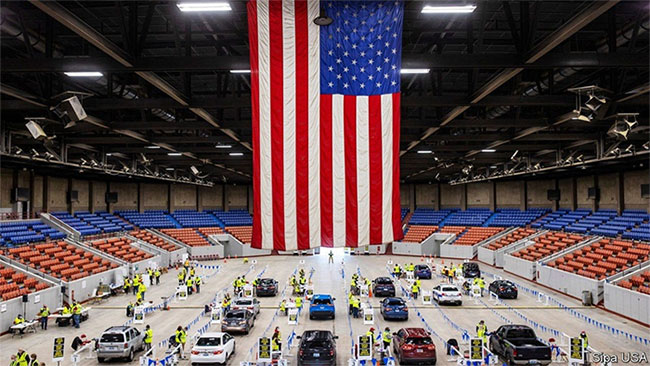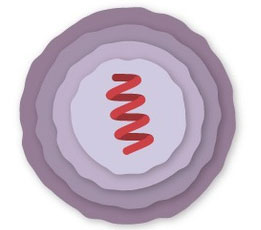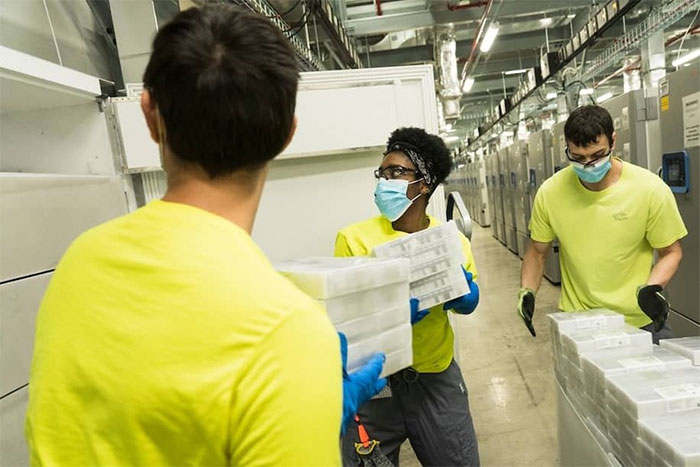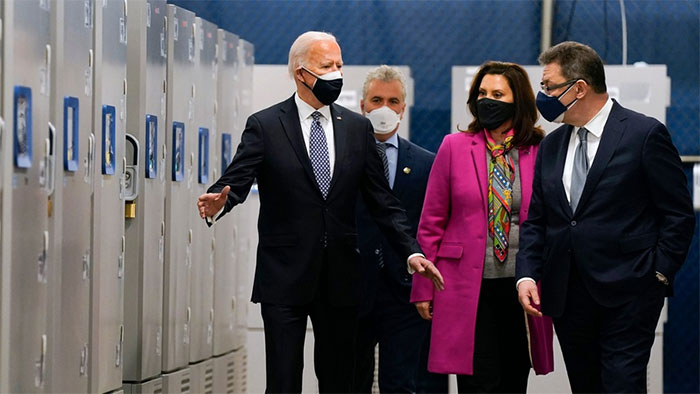In just six months, Pfizer transformed an initial failed trial into a groundbreaking vaccine production campaign, which U.S. President Joe Biden referred to as “a scientific miracle.”
Located in the suburbs of Kalamazoo, Michigan, Pfizer has a vaccine manufacturing plant. This is where Pfizer chose to produce the first batch of vaccines using mRNA technology to combat Covid-19.
Few people know that before achieving a breakthrough in Covid-19 vaccine production, Pfizer’s first attempt at large-scale vaccine manufacturing failed miserably in mid-2020.
However, within just over six months, Pfizer and its partner BioNTech achieved results that President Biden later described as “miraculous” in the development and production of vaccines, opening up opportunities to end the Covid-19 pandemic.
Starting from Scratch
Before the pandemic broke out, Pfizer and several other pharmaceutical companies, such as BioNTech and Moderna, had been researching the application of mRNA technology in vaccines for diseases like influenza, HIV, tuberculosis, rabies, malaria, Zika, as well as cancer treatments.
On March 20, 2020, Mr. McEvoy, the operations director of the Kalamazoo plant, received a letter from Chaz Calitri, the vice president of Pfizer responsible for operations in the U.S. and Europe.
Three days earlier, Pfizer announced a partnership with the German biotechnology company BioNTech to develop and produce a trial coronavirus vaccine.
At that time, BioNTech had discovered a way to use mRNA vaccines to combat the coronavirus. However, the German company needed a partner with large-scale manufacturing capabilities, technical expertise, and the ability to distribute vaccines globally.

A Covid-19 vaccination center in the U.S. (Photo: Reuters).
Calitri was one of the Pfizer executives who selected the Kalamazoo plant as the site for formulating, producing, packaging, and distributing the vaccine. Kalamazoo is one of the largest steroid manufacturing facilities in the world.
When starting the project, Mr. McEvoy faced the reality that every key step in the vaccine production process would have to be built from scratch. At that time, the machinery needed to combine lipid nanoparticles with mRNA, as well as to filter the final product, did not exist.
In July 2020, Pfizer secured its first agreement to sell 100 million doses of the Covid-19 vaccine to the U.S. government for $1.95 billion.
During this month, Mr. McEvoy and several other Pfizer leaders brought officials from the Trump administration, responsible for the Covid-19 vaccine development program Operation Warp Speed (OWS), to tour the manufacturing facility in Kalamazoo.
But at that time, all McEvoy could show the U.S. officials was an empty space, accompanied by Pfizer’s strong commitment to the success of the vaccine.
“This is where hundreds of freezers will store the final products at -70 degrees Celsius. This is where the vaccine will be packaged. Production rooms will be built first, transported by truck from Texas, fully equipped with machinery and piping,” McEvoy told the OWS officials.
Moncef Slaoui, an official in charge of OWS, stated he was impressed by Pfizer’s commitment. The company was utilizing everything it could from its vast human and financial resources to produce the mRNA vaccine, Slaoui said.
Pfizer purchased every special freezing device it could find from the supplier Thermo Fisher and requested Thermo Fisher to produce more.
Due to strict cold storage requirements, workers had just 46 hours to fill the vaccine into vials, each containing six doses, and store them in freezing devices before the vaccine became inactive.
Initial mistakes were inevitable. One costly mistake occurred when Pfizer ordered special freezers from Europe that could not be used. This batch of equipment is still covered in dust in the warehouse.
First Trial Failure
Pfizer’s goal was to develop a vaccine using mRNA technology that could prevent the coronavirus.
The vaccine molecules contain lipid nanoparticles, which are ultra-small fat globules that encase a strand of mRNA, helping human cells produce proteins that activate antibodies and support the immune system against future viral invasions.
However, lipid nanoparticles were a technology that had never been applied at an industrial scale in the past. Without these ultra-small fat globules, Pfizer would not be able to create the vaccine.
The vaccine production process was initiated by Pfizer in mid-2020. At this time, Pfizer and its partner BioNTech had figured out how to transition the laboratory vaccine formulation process to industrial-scale production.

Pfizer’s vaccine molecule consists of a lipid shell surrounding an mRNA. (Photo: New York Times).
Initially, Pfizer’s experts believed there was not enough time to design, manufacture, and test an industrial-scale device to incorporate mRNA into lipid nanoparticles.
Therefore, they ordered several small-scale jet mixing devices and arranged them into a series of eight parallel production systems. At that time, Pfizer’s equipment was small enough to fit on a table.
BioNTech provided Pfizer with the formula for experimental-scale production.
“They gave us a sketch of what they had on hand. That would never be enough to supply vaccines for the entire world. We had no expertise in this equipment at the time, so we had to figure out how to produce the vaccine at a commercial scale,” Jinne Adisoejoso, a pharmaceutical manufacturing expert at Pfizer, stated.
By September 11, 2020, abnormal signs appeared in the vaccine production process, Pfizer leaders later reported.
When inspecting the product at the end of the production process, Pfizer’s experts discovered that the most crucial component of the vaccine—the lipid molecule encasing the mRNA—had disappeared.
“Our first technical trial failed completely,” said Pat McEvoy, the technical and operations director at the Kalamazoo plant.

Pfizer employees transferring the vaccine to the freezer. (Photo: New York Times).
The failure in September 2020 showed that Pfizer was still far from success. The ambitious goal of vaccine production ultimately forced Pfizer to accept collaboration with the government to obtain supplies of essential components for vaccine production, despite previously trying to avoid cooperating with federal health agencies.
After the technical failure in September 2020, Pfizer’s experts discovered that the issue lay in a damaged filter, causing the lipid nanoparticles to leak out during the filtration process. Pfizer then had to check the quality of all the filters.
At the production facility in Puurs, Belgium, Pfizer’s manufacturing team used the information obtained from the Kalamazoo plant and successfully conducted a technical trial on September 14, 2020.
However, the bulky filtration machines continued to slow down production. Pfizer subsequently added more filtration areas, scaled up operations, and doubled its capacity from 1.7 million doses to 3 million doses per product batch.
Later, in the context of supply shortages, Pfizer invented a system to reuse used filters.
Two Miracles of Pfizer
On November 9, 2020, the results of clinical trials brought promising signals as Pfizer’s vaccine achieved over 90% efficacy in preventing Covid-19, opening the door to hopes of ending the pandemic.
However, at that time, Pfizer had to cut its vaccine production for 2020 from 100 million doses to 50 million doses.
In a subsequent announcement, Pfizer stated that, in addition to issues in the manufacturing process and raw material supply, the delayed results of clinical trials meant the company did not have enough time to produce as initially committed.
On December 11, 2020, the U.S. Food and Drug Administration (FDA) granted emergency use authorization for Pfizer’s vaccine.
On December 13, 2020, the first batches of Pfizer’s vaccine left the Kalamazoo facility to be delivered to federal stockpiles.
As Pfizer’s vaccine showed potential as a solution to end the pandemic, the administration of former President Trump requested Pfizer to supply an additional 100 million doses, compared to the initial commitment of 100 million doses.
At this point, the Trump administration, and later the Biden administration, held what Pfizer wanted.
The White House had the authority to activate the Defense Production Act—a law that allows the government to control the production of industrial products in a national emergency—to help Pfizer gain priority access to the raw materials and equipment necessary for vaccine production.

President Joe Biden visits Pfizer’s manufacturing facility in Kalamazoo. (Photo: Reuters).
By December 22, 2020, former President Trump placed Pfizer on the priority list for purchasing lipids under the Defense Production Act. Pfizer later announced it would sell an additional 100 million doses of vaccine to the U.S. government.
“The reality is that they needed help. Allowing other manufacturers to buy equipment and components (to produce vaccines) would harm Pfizer. We had previously used the Defense Production Act to help Moderna acquire lipids and assist other companies in purchasing sterile bags. Pfizer would be at the end of the queue for purchases,” said Mr. Slaoui.
After taking office, the Biden administration announced it would use the Defense Production Act to help Pfizer gain priority in purchasing pumps and filters.
Pfizer’s engineers stated that expanding filtration capacity was crucial for increasing vaccine production.
President Biden personally visited Pfizer’s manufacturing facility in Kalamazoo. There, he toured the freezing storage equipment and witnessed workers packing vaccines for shipment to states, using dry ice produced by Pfizer itself.
After the “scientific miracle” of producing a vaccine using mRNA technology, Pfizer’s success in Kalamazoo was the “second miracle—production miracle—helping to create hundreds of millions of vaccine doses,” President Biden praised Pfizer.



















































